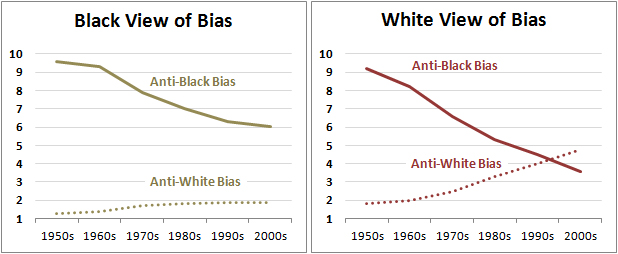Bruce Bartlett has written a new paper that examines the role of “reverse racism” in the rise of Donald Trump. Bartlett touches on a number of topics—e.g., changing demographics, partisan realignment, the media promotion of race as an in-group marker—but the cornerstone of his narrative is a simple recognition that fear of reverse racism is deep and pervasive among white Americans. Here’s the basic lay of the land from a bit of research done a few years ago by Michael Norton and Samuel Sommers:

As you can see, everyone agrees that racism was endemic in the ’50s, and everyone agrees that it has improved since then. But among whites, a majority believe racism against blacks has improved so much—and reverse racism against whites has intensified so much—that today there’s actually more bias against whites than against blacks.
The Norton-Summers study doesn’t break down racial views further, but it’s a safe guess that fears of reverse racism are concentrated primarily among political conservatives—encouraged on a near daily basis by talk radio, Fox News, and Republican politicians. Given this, it’s hardly any wonder that Trump’s barely coded appeals to racial resentment have resonated so strongly among Republican voters. Trump himself may or may not have any staying power, but his basic appeal is rooted in a culture of white grievance that’s been growing for years and is likely to keep growing in the future as white majorities continue to shrink. No matter what happens to Trump himself, he’s mainstreamed white victimhood as a political force to be reckoned with for the foreseeable future.


















